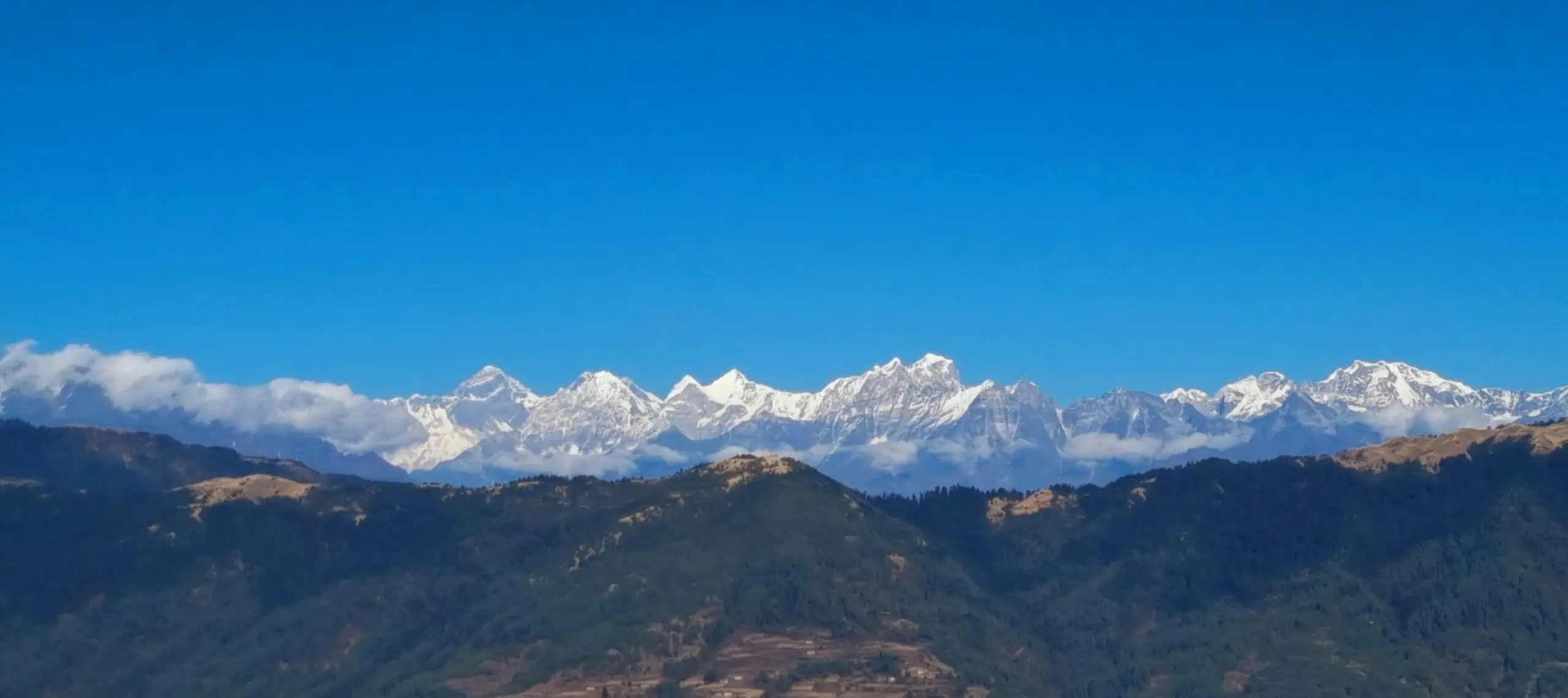
Mera Peak Climbing 18 Days
USD 2,380 per person
| Activities | - | Fitness Level | Strenuous |
| Max Elevation | 6476m | Commute | Flight to Lukla to Kathmandu |
| Best Month | Autumn,Spring,summer,winter | Group Size | Min: 2, Max: 10+,single |
| Arrival on | Kathmandu | Depart From | Kathmandu |
| Meal | B L D | Duration | 18 Days |
| Stay | Hotel & Tea House | Price | USD 2,380 per person |
Climbing the technically straightforward -Mera peak following the least trodden route of the Everest region entering the incredible Hinku Valley. Mera Peak (6476 m) is the most popular and the highest trekking peak of Nepal that fascinates the spectacular views of peaks over 6000 m including the highest peak Mt. Everest (8848m) piercing the skyline. This technically straightforward
Mera Peak Climbing is outstanding for those who wish to experience true mountaineering in Nepal. Passing some crevasses to maneuver around, the route can be long and demanding with the snowfall. Taking a thrilling Lukla flight, the route will enter the isolated Hinku valley of Makalu Barun National Park enjoying the less trodden route to the Mera peak. Standing to the south of Mt. Everest, Mera Peak provides the 360-degree panoramic views of 5 world\'s highest mountains over 8000m:
Mount Everest(8848m), Kangchenjunga(8586m), Lhotse(8516m), Makalu(8485m) andCho Oyu(8201m) as well as many other peaks of Khumbu Region. Our Mera Peak Climbing itinerary allows sufficient time for proper acclimatization making a comfortable ascent of this physically challenging climbing. Even the first-timers who have no experience of mountaineering could summit the peak following the instruction given by our experienced climbing Sherpas. We also provide some basic mountaineering training like how to use ropes, crampons, and other necessary pre-climbing training before the summit day. Best Time to Climb Mera Peak- Spring (March, April, and May) & Autumn (September, October, November).
Outline Itinenary:
Day 01: Arrival day in Kathmandu (Altitude: 1,300m/4,264 ft. Meal: Dinner)
Day 02: Option for Kathmandu Cultural Tour or Indoor Climbing Course in Kathmandu (Altitude: 1,300m/4,264 ft. Meal: Breakfast)
Day 03: Fly to Lukla & trek to Chutanga (Altitude: Chutanga: 3,450m/11,320 ft. Lukla: 2,800m/9,186 ft. Flight: 35 min Trek: 3/4 hrs. Meal: BLD)
Day 04: Trek to Tuli Kharka via Zatrwa La (Altitude: Tuli Kharka: 4,250m/13,944ft. Zatrwa la: 4600 m/14720 ft. Trek: 5/6 hrs. Meal: BLD)
Day 05: Trek to Gothey (Altitude: 3600m/11,812ft. Trek: 5/6 hrs. Meal: BLD)
Day 06: Trek to Thagnag (Altitude: 4,350m/14,272ft. Trek: 5/6 hrs. Meal: BLD)
Day 07: Acclimatization day at Thagnag (Altitude: 4,350m/14,272ft. Meal: BLD) Day 08: Trek to Khare (Altitude: 5,025m/16,486ft. Trek: 3/4 hrs. Meal: BLD)
Day 09: Ice climbing practice near Khare (Altitude: 5,025m/16,486ft. Meal: BLD) Day 10: Trek to Mera base camp (Altitude: Mera La : 5,415m/17,766ft. Base Camp: 5,350m/17,552ft. Trek: 3/4 hrs. Meal: BLD)
Day 11: Climb to Mera high camp (Altitude: 5,750m/18,865ft. Trek: Meal: BLD) Day 12: Summit day and descend to Khare (Altitude: 6476m/21,241ft. Trek: 8/9 hrs. Meal: BLD)
Day 13: Contingency Day
Day 14: Trek to Gothey (Altitude: 3600m/11,812ft. Trek: 4/5 hrs. Meal: BLD)
Day 15: Trek to Tuli Kharka (Altitude: Tuli Kharka: 4,250m/13,944ft. Trek: 4/5 hrs. Meal: BLD)
Day 16: Trek to Lukla (Altitude: 2,800m/9,186 ft. Trek: 3/4 hrs. Meal: BLD)
Day 17: Fly back to Kathmandu (Altitude: 1350/4428 ft. Flight: 30 minutes Meal: B/D)
Day 18: Departure from Kathmandu (Altitude: 1350/4428 ft. Meal: B)
Costs
What is included
🟢Airport transfer with an escort in a private vehicle
🟢Fully catered camping trek during summit days
🟢12/13 nights’ accommodation with meals at well and comfortable Mountain Lodge available en-route during the trek (Few nights’ at during trek with attached bathroom/toilets)
🟢English speaking, First Aid and Eco-trained local trekking guide, Assistance guide as per the group size, porters (2:1)
🟢Exclusive medical kit bag, Duffle Bag, Trekking T-shirt, Adventure Certificate
🟢Equipment allowance for the guide
🟢Mera peak climbing permit
🟢Helicopter rescue, accidental medical insurance for Climbing Sherpa
🟢3 nights’ accommodation at Tourist standard Hotel in Kathmandu with Breakfast
🟢Domestic Airfare for the sector Kathmandu/Lukla/Kathmandu
🟢General Climbing equipment such as Rope, Ice Screw, Snow Bar etc.
🟢Equipment clothing for porter & staffs
🟢Insurance for all staff & porters
🟢Applicable local and government taxes and VAT.
What is not included
🔴Nepal Visa - (Cost- US$- 30 for 15 days & $- 50 for 30 days)
🔴Lunch & evening meals while in Kathmandu
🔴Travel insurance
🔴Cost of personal nature expenses, Beverages (Mineral water or coca-cola), cost of extra meals, snacks, phones bills, Internet, WiFi, laundry, etc.
🔴The cost incurred during emergencies, evacuations
🔴Tips for Guide/porters/driver ...
🔴Any other expenses not included in “Service Includes”
Gears Required:
Personal Climbing Gears:
Ice axe Crampons Harness Tape Slings (2) Screwgate Karabiners (2 lock, 2 unlock) Descender/Abseil Device Plastic Mountaineering Boots Ascender Helmet (optional)
Group Climbing Gears:
Snow bar* Rope* Ice Hammer* Ice Screw*
Map

Altitude Chart

DETAILED ITINERARY
Day 01: Arrival day in Kathmandu (Altitude: 1,300m/4,264 ft. Meal: Dinner)
On your arrival at Kathmandu International Airport, one of our representatives will pick up you and escort you to the hotel as well as help you to check-in at hotel. After your refreshment, you will be briefed about the next day trip. In the evening, we, the Hiking Nepal will offer you a welcome dinner introducing Nepalese cuisine and culture.
Day 02: Option for Kathmandu Cultural Tour or Indoor Climbing Course in Kathmandu (Altitude: 1,300m/4,264 ft. Meal: Breakfast)
After the long flight to Kathmandu, a day is spared to rest before the trek. Depending on your interest, today, we have the option of a day tour to Kathmandu Cultural Heritage site and another option is the indoor climbing.
Day 03: Fly to Lukla & trek to Chutanga (Altitude: Chutanga: 3,450m/11,320 ft. Lukla: 2,800m/9,186 ft. Flight: 35 min Trek: 3/4 hrs. Meal: BLD)
Wake up early morning and get ready after taking light breakfast for a short drive to Kathmandu Domestic Airport to fly Lukla. It will be the scenic half an hour flight over the snowcapped mountains to one of the most electrifying high altitude airports, Lukla at an altitude 2900 m. Your guides and porters will accompany you here for the trek. Hence, the trekking adventure kicks off. It will be an easy trek walking towards east passing number of hamlets and wooden Yards taking you to a thick forest of silver fir, birch, pines and rhododendron. You will make a steady progress on a good trail, crossing ridges and streams up to “Kharka”, the summer pasture used for grazing yaks. The whole area is called as Chutanga where you are spending your first night.
Day 04: Trek to Tuli Kharka via Zatrwa La (Altitude: Tuli Kharka: 4,250m/13,944ft. Zatrwa la: 4600 m/14720 ft. Trek: 5/6 hrs. Meal: BLD)
Begins the adventure trekking with a steep climb to cross the Kalo Himal ridge in the Nau Lekh range which separates the Khumbu Valley with Hinku valley. With a steep climb up to a ridge, you will see the flattering colorful flags and the spot is called as Zatrwa la. Then, you will finally descend steeply to the Tuli Kharka. Spend overnight at Mountain lodge.
Day 05: Trek to Gothey (Altitude: 3600m/11,812ft. Trek: 5/6 hrs. Meal: BLD)
After breakfast, starts walking in a descending trail for a while and then crossing few ridges, you will walk steeply down to the Hinku River. Then, slightly ascending uphill will takes you to Gothey of Hinku valley. Here, you can see several seasonal lodges/teahouses for check-in. Spend time exploring the local lifestyle. Overnight at Mountain Lodge.
Day 06: Trek to Thagnag (Altitude: 4,350m/14,272ft. Trek: 5/6 hrs. Meal: BLD)
Today, you will walk along the Ridge of Hinku River in the shadow of Mera Peak. In the west bank of Hinku Drangka, lies Gondishung, where you will take lunch and rest for a while. Gondishung is a summer herders’ settlements. From here, you will pass an ancient Gompa- Lungsumgba Gompa, consider to be 200 years old. Tradition before heading from here is offering a Juniper incense to the shrine to ensure a successful ascend of Mera peak. From here, just a short walk will take you to the Thagnag. It is a pasture land for grazing Yak during summer. Spend Overnight at local lodge.
Day 07: Acclimatization day at Thagnag (Altitude: 4,350m/14,272ft. Meal: BLD)
For further trek, you will require to be more technical. Hence, it will be the perfect time for proper acclimatization. Today, you will learn some climbing technique from the Guide and practice before heading to base camp. Take your time in practicing climbing with short hiking. You can go for hike to the huge moraine in the north of Tragnag. Explore the beautiful glacial lake- Sabal Tsho. Additionally, a cairn (5,270m/17,290ft) on the flanks of Kusum Kangguru can also be rewarding and beneficial for acclimatization. After hiking, retrace back to Thagnag for overnight stay.
Day 08: Trek to Khare (Altitude: 5,025m/16,486ft. Trek: 3/4 hrs. Meal: BLD)
Today, you will move to the base camp of Mera peak towards east following the lateral moraine of Dig Glacier to the pasture called as Dig Kharka. From here, you can click the fabulous view of Charpate Himal. You will follow rocky trail, and the lateral moraine up to the snout of Hinku Nup and Shar Glaciers, then onwards, starts walking on the steeper trail until you reach to Khare for overnight stay in a camp.
Day 09: Ice climbing practice near Khare (Altitude: 5,025m/16,486ft. Meal: BLD)
Today, you will engage in practicing ice climbing. After breakfast, get involve in preparing individual gear for ice climbing. Ice Climbing depends on the season and availability of ice; hence, in case of unavailable, you can hike around and rest at camp. Meantime, walking just a couple of hours from Khare, you will reach to a point from where, you can enjoy the clear view of Mera la and the route up to the mountain. Here, you can practice ice climbing. Follow the instruction of guide and practice for few hours in the glaciers. Then retrace back your to camp and make final preparation to summit Mera peak.
Day 10: Trek to Mera base camp (Altitude: Mera La : 5,415m/17,766ft. Base Camp: 5,350m/17,552ft. Trek: 3/4 hrs. Meal: BLD)
Today, you will make your way to Mera Base Camp. It will be a very short trek letting you acclimatize. You will climb to the crest of the moraine to steep slope of scree or snow to reach a boulder strewn bowl below the lower tongue of the Mera Glacier. Reaching the pass Mera La, you can see the enjoy the surrounding, then descend for a while towards the Hongu side and set up base camp in the moraine below the ice where you will camp for overnight stay.
Day 11: Climb to Mera high camp (Altitude: 5,750m/18,865ft. Trek: Meal: BLD)
You should be very much careful on your way to high camp. The trail can be hazardous if it has recently snowed, as there are a number of crevasses en-route. Making your way to the top of the rock band, which is marked by large cairn, you will set up high camp. It will be the final camp before ascending the peak. Let yourself refreshed with the outstanding view of mountain piercing the skyline. Your stay will be at high camp.
Day 12: Summit day and descend to Khare (Altitude: 6476m/21,241ft. Trek: 8/9 hrs. Meal: BLD)
Here comes the most awaited day of the entire trip. Today, you are going to summit Mera Peak. And you should wake up early at around 2 o’clock and get ready with crampons and rope. From High Camp, a well acclimatize group will summit peak in 3-4 hours. Just reaching at the peak, you can see the magnificent view of Mt. Everest (8,848m), Cho-Oyu (8,201m), Lhotse (8,516m), Makalu (8,463m), Kangchenjunga (8,586m), Nuptse (7,855m), Lubuche (6,145m), Chamlang (7,319m) and other mountains over 6 thousand meters. Taking some snap and enjoying the spectacular views of snowline, you will retrace your journey back to Khare after a while rest with some hot soup at high camp. Spend overnight at Khare.
Day 13: Contingency Day
Weather in the Himalayas is quite unpredictable. Hence, it is good to take on contingency day considering unfavorable weather or any other obstructions that might delayed the group in climbing peak. If the group summit the peak in the planned date and everything goes well, this day could be cut off from the itinerary.
Day 14: Trek to Gothey (Altitude: 3600m/11,812ft. Trek: 4/5 hrs. Meal: BLD)
Today, you will descend through the Hinku valley to the Gothey on the same trail used earlier. Enjoying the surrounding you can celebrate the success with some local wines or the way you like to relax yourself. Spend overnight at lodge in Gothey.
Day 15: Trek to Tuli Kharka (Altitude: Tuli Kharka: 4,250m/13,944ft. Trek: 4/5 hrs. Meal: BLD)
Begins climbing up through the lush forest of Rhodoneddron, Bamboo and Pine, on the west side of the Hinku valley to the Tuli kharka for your overnight stay.
Day 16: Trek to Lukla (Altitude: 2,800m/9,186 ft. Trek: 3/4 hrs. Meal: BLD)
Today, you will finally enter to the Lukla and is the last day of your trip. You will walk upwards from the Tulikharka to Zatrwa la top. Then onwards, you will walk all the way down to Lukla via Chutanga. On your arrival at Lukla, you will be accommodated in lodge. Take rest and make your evening wonderful spending your quality time with group and crew member celebrating your success. Spend overnight at lodge.
Day 17: Fly back to Kathmandu (Altitude: 1350/4428 ft. Flight: 30 minutes Meal: B/D)
You will board a plane back to Kathmandu. Arriving at Kathmandu you will be transferred to your hotel and rest of the day will be your leisure time. You can go for shopping, message, or rest at Hotel. Evening time, we invite you for farewell dinner at authentic restaurant. You can share your experience, feedback us and give us a chance to make your evening a wonderful time. Overnight at Hotel.
Day 18: Departure from Kathmandu (Altitude: 1350/4428 ft. Meal: B)
Now it’s a time to say good bye. You will be receive at Hotel to transfer you at the airport for your departure. Additionally, if you wish to spend some more days, you can let us know, we shall organize the services accordingly.
DEPARTURE DATES
| START DATE | END DATE | STATUS | PRICES |
|---|---|---|---|
| 15th Oct | 2nd Nov | Limited Seats |
$ 2,380
|
| 19th Oct | 6th Nov | Limited Seats |
$ 2,380
|
| 22nd Oct | 9th Nov | Limited Seats |
$ 2,380
|
| 25th Oct | 12th Nov | Limited Seats |
$ 2,380
|
| 29th Oct | 16th Nov | Limited Seats |
$ 2,380
|
FAQ
No FAQs available for this tour.
REVIEWS
RELATED TRIPS

Sunder Peak Trek
Sunder Peak, a short trekking in the Everest Region follows the traditionally and historically impor...
More Details
Pikey Peak Trek
Pikey Trek- short and outstanding trekking to the Himalayas viewing the stunning Himalayas including...
More Details
| 1 person | 2-7 person | 8+ person |
|---|---|---|
|
$ 2,380
Partial Pay
|
$
2,299
/ per
Partial Pay
|
$
2,199
/ per
Partial Pay
|




- Speak to one of our travel consultants
- Call Us (24/7) : +977 9802342080
-
 WhatsApp (24/7) : +977-9802342080
WhatsApp (24/7) : +977-9802342080
Planning a Trip?
We have a pool of travel experts working in this industry for more than a decade. Consult to get started
BOOK A CALL